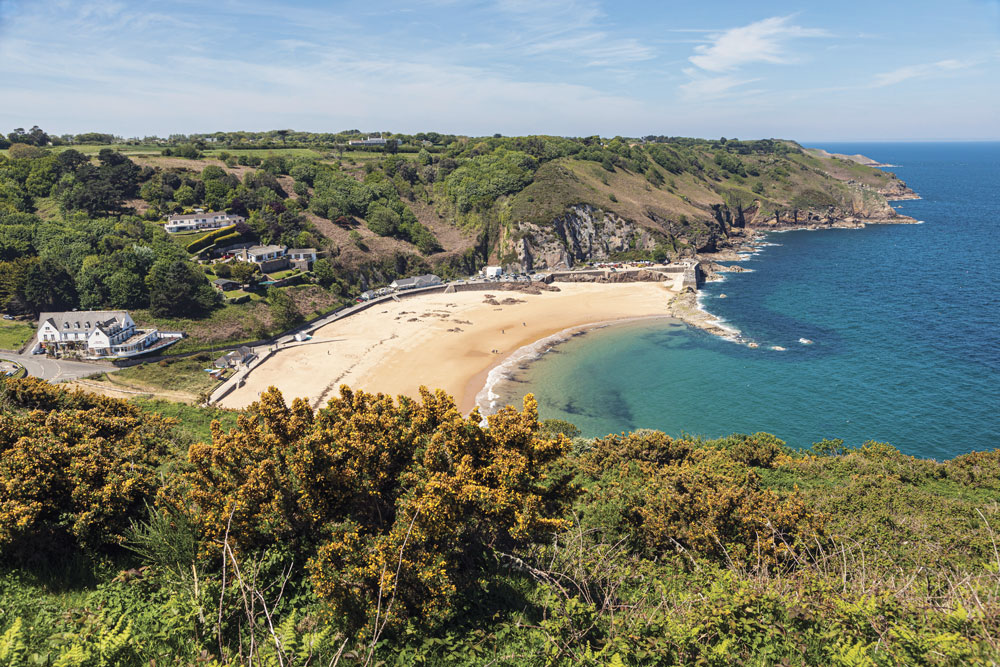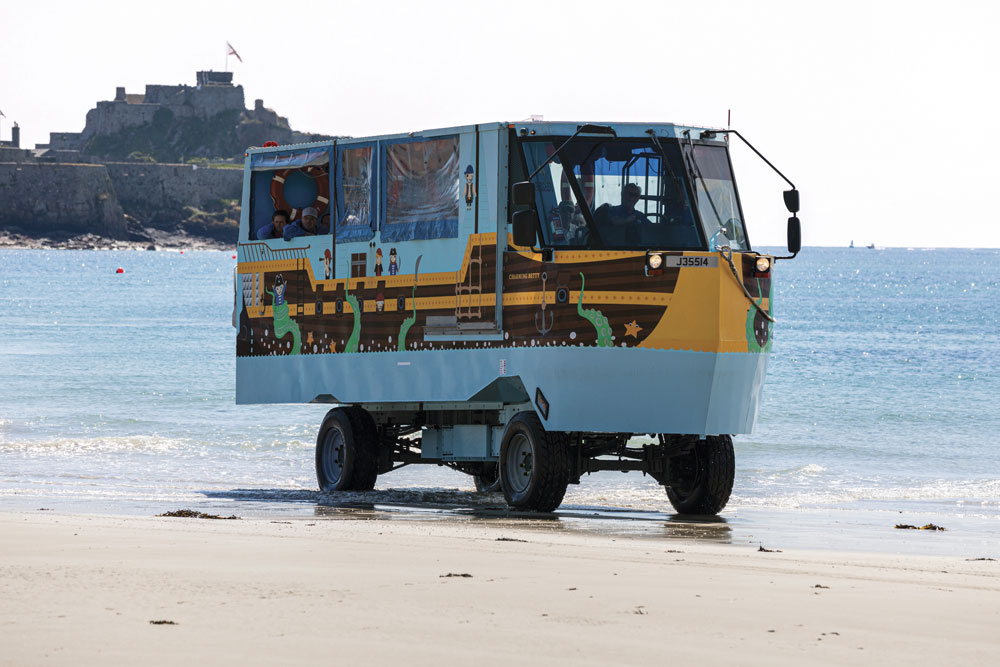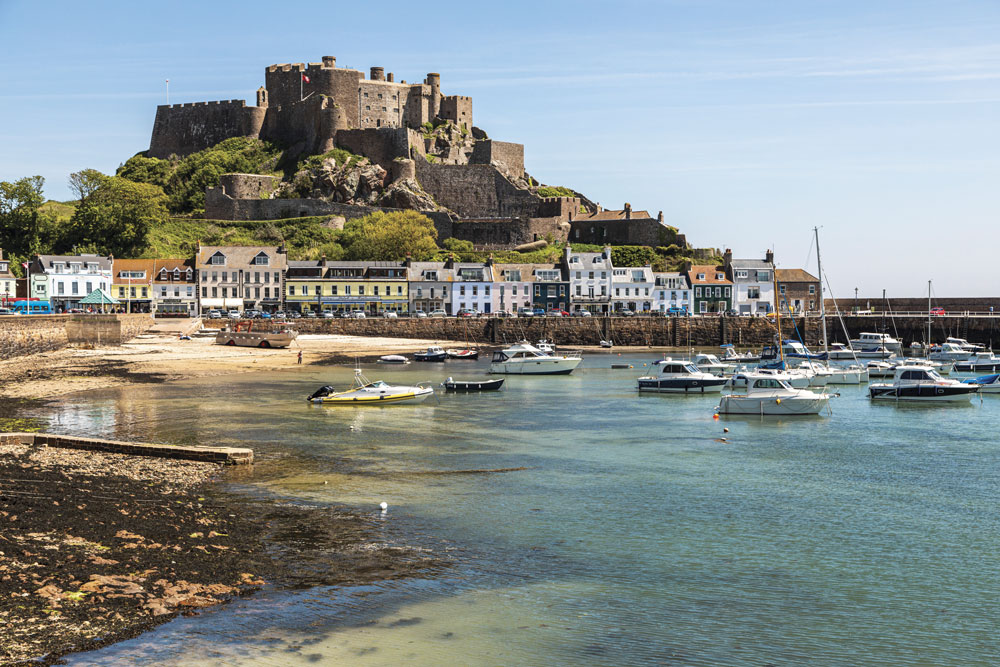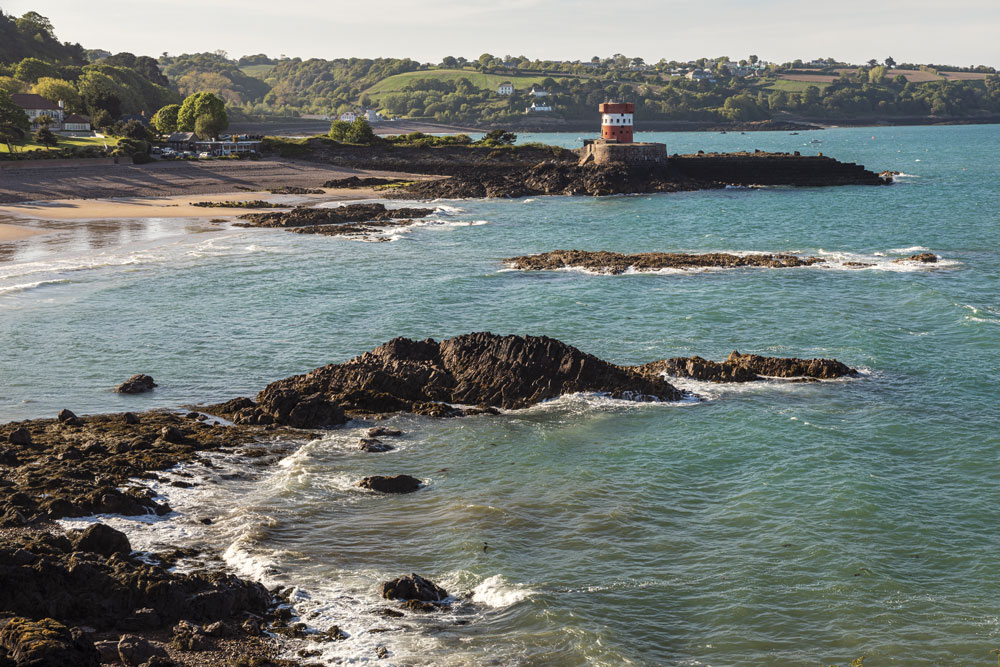Motorhome travel: Camping and motorhome touring in Jersey
Words: Helen Werin Photography: Robin Weaver
There was one thing that kept puzzling me during our entire time on Jersey: why had we not been here before? We had eight days to explore and, over the first day or two, I’d fretted that I hadn’t allowed nearly enough time for our visit. Jersey’s just so gorgeous; I wanted us to see everything.
From the moment I’d seen Jersey from the deck of the Commodore Clipper (Condor Ferries), my anticipation had mounted. I’d leaned over the rail, pointing excitedly at an eye-catching bay of golden sands with a red and white tower in the middle. “Wow, we’ve just got to go there!” My thoughts then were that my ‘must-see’ beach would be easy to seek out because of its distinctive tower. I was soon to discover that it was to be the first of many fabulous bays and many similar towers.
Our 10-hour crossing to Jersey had felt like a mini-cruise, giving us the chance to see some of the appealing coast of Herm and Guernsey and – slightly farther off – Sark along the way. We quickly slipped into Jersey’s easy pace of life. Since the island is just nine miles by five, we were never more than about a 10-minute drive from its dazzling coastline.

Campsites in Jersey
Our campsites, very quiet early in the season, were top notch and well-placed for making the most of our time.
As it turned out, the lunch spot on the first day was at the very beach that I’d spotted from the ferry – Ouaisne Bay.
“It doesn’t get better than this,” I mumbled through mouthfuls of our Mexican-style meal from Kismet Cabana right on the sands.
The locals take great pride in their island. One after another they asked us, “It’s beautiful here, isn’t it?” with an ingenuous expression, confident that we couldn’t possibly disagree.
We thought ourselves very lucky; sparkling sunshine every day enabled us to see Jersey in its very best light. It’s so lush and colourful.
We worked up appetites by stepping out in landscapes varying from the dramatic north coast cliffs to the sheltered bays of the south and east, and across to the seemingly endless stretch of dune-backed beach that’s a surfer’s paradise in the west.
We scouted around a couple of famous castles and learned about how the islanders coped with five years of German occupation during WWII.
Beuvelande and beyond
Our arrival at our first campsite, Beuvelande, was marked by the appearance of a military jeep, men in military uniforms and women in Land Girl garb. It was a Liberation Day event (for charity) and we joined in the spirit with other campers in Tilleys, the on-site bar and restaurant. The wartime occupation of the Channel Islands is a constant thread, woven among the sensational scenery, a riveting and complex history and the wonderful food.
Jersey marked my first time in an amphibious vehicle. Charming Betty is one of two such ferries transporting passengers across St Aubin’s Bay at St Helier to Elizabeth Castle. It was such a strange feeling trundling across the sands like we were on a slightly rocking bus. As Betty drove deeper into the channel, the roar of her engine kicked in and we sailed across to the islet on which the castle was built at the end of the sixteenth century.

For 200 years, Elizabeth Castle was the island’s principle stronghold. It’s a compelling place, extended as events unfolded from being the last castle to surrender during the Civil War to a punishment camp during WWII. It was so hard to tear my eyes away from the panoramic views from its stocky towers over the wide sweep of St Aubin’s Bay but, in doing so, I learned fascinating snippets of castle life.
It’s actually another castle that takes centre stage in that iconic view of Jersey; Mont Orgueil Castle (aka Gorey Castle), on the east coast.

A couple of miles after leaving Beuvelande, we were on Gorey’s palm tree-lined prom, with the landmark fortress seen on all the ads and posters above the harbour. All morning we trekked up and down steep steps, under arches and along stone pathways to the keep built on a rocky outcrop, interspersed with lingering looks across the Royal Bay of Grouville to the south, north across St Catherine’s Bay and to France, just 14 miles away.
I loved ducking through all the doors, peering into dark recesses and investigating down steps to dim passages and up towers. Flanked by four-storey residential apartments built in the mid-sixteenth century and by huge walls, we experienced a wind tunnel sensation at one stage – though moments earlier I’d been sunning myself in the tiny seventeenth century garden.
A long corridor leads to a medieval hall with an impressive Tree of Succession steel sculpture showing the intertwined royal houses of France and England throughout the middle ages.
Our afternoon walk south traced the extent of those earlier enticing views from the castle to La Rocque Point along what’s known locally as Long Beach, popular with kite surfers, then onto a public path edging the Royal Jersey Golf Club and passing another of the many towers at Fort Henry.
To cap another fulfilling day, our return to Beuvelande endowed us with the very special treat of seeing St Catherine’s Bay sparkling prettily in the early evening light.
Jersey’s north coast beckoned, with its mesmerising vision of Guernsey and Sark.
From our pitch at our second site, the superb Rozel Camping Park, we could clearly see the Cotentin Peninsula of Normandy and, in between, the tiny Écréhous islands. Their much sought-after fishermen’s huts look like toy building bricks on specks of rock almost swallowed by the sea.
The Devil’s Hole and Plemont Bay
Driving slowly down leafy lanes, past doe-eyed, caramel-skinned cows and fields of Jersey potatoes, led us to the Priory Inn where we parked (free) for the Devil’s Hole.
Despite the name and the legends – that had pulled us here – it’s paradisiacal, or rather, the sensational view across azure waters to Sark and Guernsey is. I stood captivated by the seascape for such a long time that I almost forgot what I’d actually come here for – at high tide, water is forced through a tunnel and out of the hole, thus creating a ‘booming’ noise.
The Devil’s Hole is fenced off but, in weathered monochrome pictures displayed on the viewpoint, Victorian ladies in their ‘Sunday best’ long skirts and bonnets are standing deep within the rock-strewn hole, which became a particularly popular tourist attraction in the late nineteenth century.
I’m always amazed by such pictures; not least because I, in waterproof walking boots, which look to be far more suited to rocky terrain than those of the photographer’s subjects, can only peer curiously and enviously from above.
A particularly memorable afternoon was spent walking from Grève de Lecq westwards to Plemont Bay on a path that dips up and down and around the spectacular seaboard. I’d really begun to take things for granted on Jersey, expecting – and getting – fantastic scenery around every corner.
Annoyingly, I’d forgotten to check the tide times so, when we arrived high above Plemont (there’s a long flight of steps to the beach), the water was up. I was disappointed, having wanted to visit the caves here, especially as one of them has a waterfall over it.
My disappointment didn’t last long, swiftly assuaged by the pastoral scenes from Rozel to Fliquet Bay, dominated by another of the towers built in the 1780s to guard the east coast.
Along the way we stopped to see what’s left of the 5,000-year-old gallery grave, Dolmen du Couperon, before eating our picnic on the suntrap breakwater at St Catherine’s. We looked across the bay that we’d stopped to admire earlier in the trip and to Mont Orgueil Castle – with yet another of those red towers in between.
We headed for the Driftwood Café near the tower for a cup of tea.
As seemed to be the pattern of our explorations, there were even more unexpected treats in store as we strolled along one of the ‘green lanes’ back towards Rozel to St Catherine’s Woods Nature Reserve. What a place!
It’s like a fairy glen with stepping stones over streams, the air filled with birdsong and the hammer of a woodpecker among the dense, tall trees through which the late afternoon light filtered so exquisitely. Welly-clad children squealed as they splashed in the pond.
Back at Rozel, youngsters were splashing in the heated swimming pool (Beuvelande also has a pool). Encouraged by this tableau of fun, my husband, Robin, finally agreed to a (free) round of crazy golf... I won!
Jersey Zoo – and the Jersey War Tunnels
Jersey Zoo, famously founded by Gerald Durrell, was another highlight. Focused on protecting and conserving endangered and vulnerable species, it’s home to some amazing creatures, many of which I’ve never heard of. As a group of tamarins munched hawthorn flowers inches from our heads – dropping the petals all over us – the keeper called out, “Daisy, Joe…” and off they shot at lightning speed like a bunch of mischievous kids.
In the reptile house I learned that the tiniest brightly coloured frogs, like delicate porcelain figurines, are poisonous. Livingstone’s fruit bats with wing spans of 4½ft dangled from nets in a humid enclosure and the butterfly house was a kaleidoscope of flashing colours among the foliage; some Galapagos giant tortoises live in here, too.
Wandering through the Jersey War Tunnels, built by the Germans using slave labour, the accounts and pictures of what life was like between September 1941 and June 1944 are astounding. Among the tales of bravery and incredible escapes are stories of defiance and espionage and the islanders’ agonies about whether to evacuate or stay. What astonishes me is that Jersey continued to advertise itself as a holiday resort: ‘the perfect retreat for a wartime break’.
Our excursions around the south and west take us from St Brelade’s Bay to Mont du Grouet, culminating in a magnificent outlook to Corbière Lighthouse.
Before we left for Brittany, we reflected on the joys of our trip in the tranquil gardens at Samarès Manor.
The Japanese garden, rockeries and water features, great swathes of every colour imaginable here and heady scents of exotic plants there, left us in a blissful daze.
During the short onward journey to St-Malo (on Condor’s Commodore Rapide), I started fretting again.
We should have walked around far more of the coast and gone back to pretty Plemont to investigate Jersey’s largest caves. Oh, and we should definitely have returned to Rozel’s scenic harbour for a few more of the Hungry Man kiosk’s massive breakfast buns and super-creamy, Jersey whipped ice creams…
Never have I known so many wonderful sights – and tastes – packed into such a small area.

TAKING YOUR MOTORHOME TO JERSEY - TOP TIPS
Motorhomes up to 7m long, 3.1m high and under 4.5 tonnes can book Condor Ferries online. Otherwise you should call 03456 091024.
Gas is limited to 47kg and each bottle must be no heavier than 7kg (excluding the weight of the bottles).
You need a motorhome permit prior to arrival; they are supplied when you book registered campsites or by email [email protected]
You must stay on a registered campsite (max 31 days), display the permit and return to site each night.
Maximum speed is 40mph, with a lot of 30mph and 20mph zones. We advise not going down Green Lanes in a motorhome (narrow 15mph lanes).
Our motorhome is 2.24m wide, 2.87m high and 5.8m long; we didn’t have any problems driving around. You have to drive slowly anyway and if buses can do it, then so can we!







.jpg)



Recent Updates
Engine management lights: all you need to know
What is the engine management light? What does it mean, and what do I have to do? ...
Motorhome air suspension: all you need to know
Motorhomes are heavy and the additional weight of equipment and height of the bodywork can increase the loads ...
Motorhome WiFi: how to get better motorhome internet
Staying connected on the move is more and more essential, so relying on campsite WiFi isn't an option – here ...
A class of their own - our guide to A-class motorhomes
Thinking of trading up to an A-class, or even going straight to the top of the motorhome tree? We guide you ...
Explore overseas on a motorhome dream tour
Enjoy exotic travel in a campervan or motorhome by hiring, swapping with someone else or exporting your ...
Motorhome water systems: everything you need to know
On-board water is an important part of every motorhome – here’s everything you need to know ...
Campervanning in Europe: what you need to know
Whether you're planning a leisurely drive through the French countryside, navigating bustling city streets in ...
Campervan security: all you need to know
With thefts on the increase, it’s important to know how to keep your campervan secure and prevent campervan ...
Campervan furniture: everything you need to know
Our campervan experts guide you through all the essentials for your campervan, including tables, chairs, ...
Campervan finance: how to fund your purchase
Here we look at the different types of campervan finance available, to help you decide what’s the best option ...
Other Articles
Britain’s best used motorhomes
Want a great motorhome without paying the premium for a new one? Here's a guide to the best you can get in the pre-owned market for each layout, ...
Which motorhome? Choosing the perfect motorhome for you
Choosing a motorhome or campervan is one of the biggest buying decisions you’ll ever make, so it's important ...
Campervan washroom essentials: stay fresh on the road
Our guide will take you through the campervan washroom essentials you'll need so you're well-prepared for ...
Dogs in campervans: all you need to know
Follow our advice and your dog will enjoy campervanning as much as you do ...
Electric campervans: all you need to know
Our guide will take you through everything you need to know about electric campervans and what the future ...
Motorhome electrics: a complete guide to your motorhome electrical set-up
Motorhome electrics can dramatically enhance the convenience and comfort of your vehicle – but they can be ...
Lighting for campervans: all you need to know
We guide you through all the lighting options available for you and your campervan, including interior ...
Electric bikes for motorhomes: our ultimate guide
Read our comprehensive guide to electric bikes for motorhome owners, helping you add electric power to your ...
Our guide to 'cheap' motorhomes in 2024
If you're on the hunt for an affordable new motorhome, this is the best place to start – we've rounded up a ...
Campervans in winter: all you need to know
Here's your guide to preparing your campervan for the colder months, whether you will be using it or putting ...